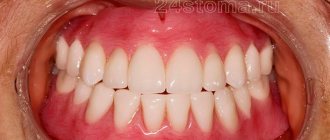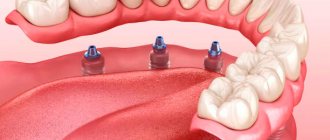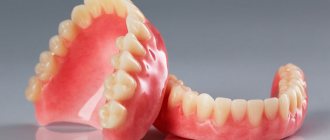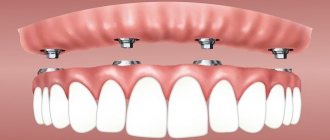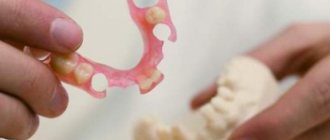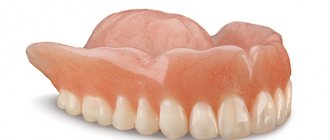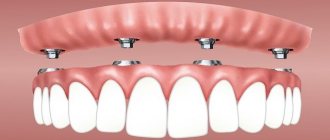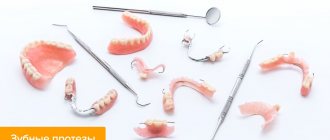Removable dentures: the fastest and cheapest way to replace teeth
Removable dentures are products with a soft or hard base that imitates the mucous membrane of the oral cavity, and artificial teeth. They can be partial or complete, that is, replace a segment of the dentition or the entire jaw. A partial removable denture has special hooks - metal made of clasp wire (clasp-based denture) or plastic, which cling to the teeth, and a complete removable denture is fixed in the oral cavity due to the valve zone.
It is believed that removable dentures are now hopelessly outdated, but they have their advantages, thanks to which this solution is still in demand.
A)
Perhaps their most important advantage is the price. The cost of a removable denture depends on the material and the number of teeth being restored, however, even the most expensive removable denture costs several times less than a similar design on implants.
b)
Typically, such prostheses are manufactured within 2 weeks and do not require surgical intervention, unlike implantation. It is no secret that most patients try to avoid any surgical interventions and often choose removable dentures for this very reason.
c)
If 40-50 years ago removable dentures did not look very natural, then modern solutions (silicone removable dentures, orthopedic structures using composite teeth and individual options for coloring the base of a removable denture) can satisfy even the most demanding patient.
Crowns: what are they?
Depending on the composition they have indications and contraindications. Many people wonder how they are made and what they consist of dentures and their parts. Let's look at each type separately.
Metal
There are cast and stamped. They are widespread due to their low cost, as well as ease of implantation and maintenance, but have lost their relevance due to the use of more modern analogues.
They can be made of nickel, titanium, gold, silver, cobalt. The downside is complete unattractiveness.
Plastic
They are made with or without a finished frame. Attractive and beautiful design, together with simple and cheap installation, can make them leaders in application. Low strength and fragility are the main disadvantages of polymer dentures and structures. In addition, plastic is a highly allergenic component.
Used for restoration, correction of anterior incisors (low load) and temporary solutions, while a permanent option is in development.
Metal-ceramic
Metal base, in the upper layers of which a ceramic coating is applied. The most common: ideal price-quality ratio. Strength, durability, the ability to be inserted into any place are advantages. The disadvantages include a possible change in color over time (requires additional care and protection), may be rejected or lead to inflammation of the gums.
Porcelain
Porcelain implants are made using press casting followed by firing. Aesthetic, strong and durable, while completely anti-allergenic. However, the high price threshold greatly reduces the application.
Zirconium dioxide crowns
After smelting, they are able to completely copy the natural external structure of the teeth. The high cost and the impossibility of subsequent adjustments after smelting the structure make this material rare. However, high strength and durability are its advantages.
Disadvantages of removable dentures
- With functionality and convenience, things are much worse. If we take the entire row of natural teeth to be 100% efficient at chewing food, then a complete removable denture (due to its design features) will allow us to achieve only 30% of the maximum capabilities.
- Another big problem with a complete removable plate denture is the unsatisfactory fixation of the prosthesis in the oral cavity. Even a properly made complete removable plate denture will not always stay well in the mouth when speaking and chewing. Also, such a prosthesis can lead to impaired diction and overlap of tactile and temperature receptors.
- A removable denture requires constant and regular correction. Food getting under the denture, the need for constant cleaning and treatment, the sensation of a foreign body in the oral cavity - this is not a complete list of problems that arise in patients who choose removable dentures.
- It is important to understand that any removable dentures without implants will not stop the process of bone tissue atrophy, which inevitably occurs after the loss of a natural tooth. Only an implantation procedure can stop bone loss.
Possibilities of a conditionally removable denture supported by natural teeth
A fixed bridge supported by your own teeth will help replace 1 to 4 missing teeth in a row. The undoubted advantage of such dentures is a better restoration of chewing function compared to removable dentures, the absence of discomfort and good aesthetic characteristics. Bridges do not need to be maintained or adjusted: up to a certain point, the patient may not notice them at all. Of course, this design will also cost significantly less than an implant-supported prosthesis. But there are some nuances here too.
✔
With a classic bridge, only a few teeth can be restored, because the supporting teeth also need to be taken into account. For example, to replace 1 tooth, the patient is given a prosthesis on 2 supporting teeth.
✔
Abutment teeth (even completely healthy ones) must be ground down for crowns.
✔
In this case, the tissues surrounding the tooth, the so-called periodontium, have an increased chewing function, taking on the load of the missing tooth. Over a long period of operation, the reserve forces of the periodontium of the supporting teeth will weaken, which, as a consequence, sooner or later will lead to their loss. That is why the service life of bridges, as a rule, does not exceed 7-10 years.
Why is implant-supported prosthesis considered the best solution?
I.
The dental implant method allows you to restore lost teeth using single crowns, bridges and full dentures supported by implants. Such a prosthesis, even in the absence of all teeth, completely restores chewing function.
II.
The implant completely replaces the root of a natural tooth: it receives the load from the crown and distributes it to the bone tissue, so that it does not undergo atrophy. Simply put, with the help of dental implants, the doctor restores the natural function of chewing to the fullest extent possible. Feedback from patients about implantation, especially from those who have previously used prostheses of other designs, will be positive in the vast majority of cases.
III.
The service life of an intraosseous dental implant (if its installation was carried out efficiently) is practically unlimited. We see patients who had implants installed more than 30 years ago. Particular attention should be paid to self-discipline and compliance with all rules of oral hygiene. The patient must understand that the presence of implants increases the requirements for daily hygiene (using not only a toothbrush, but also an irrigator) and implies regular (2 times a year) professional oral hygiene. Thus, the long-term functioning of implants is not only the competent work of the doctor, but also the responsible attitude of the patient himself to his health.
How many implants are needed to install a prosthesis?
➢
Restoration of several teeth. It is optimal when implants replace every lost tooth. If 3 teeth are missing, we install 3 implants and replace each implant with a separate crown. We get maximum and natural restoration of chewing function and the best aesthetic result. It is possible to install 2 implants when replacing 3 lost teeth - this is already a bridge prosthesis. The chewing function is restored completely, but restoration of ideal aesthetic parameters can be difficult, as well as hygiene.
➢
Restoration of a completely toothless jaw
- Conditionally removable and removable dentures on implants.
When rehabilitating patients with complete edentia, it is not always possible to make a fixed dental prosthesis supported by implants. With prolonged absence of teeth and when using complete removable dentures, atrophy of the alveolar process and narrowing of the dentition occur. In the absence of the required volume of bone tissue and mucous membrane of the alveolar process, especially in the lateral parts of the jaws, implants as a support for a conditionally removable denture can be installed in the front part of the jaw. The base of such a prosthesis can imitate part of the mucous membrane, which creates an additional cosmetic effect. There are different types of fixation of conditionally removable plate prostheses supported by implants: a beam fixation system, fixation of the prosthesis on ball-shaped abutments, a telescopic system, etc. - Fixed dentures on implants.
If there is a sufficient volume of bone tissue or if teeth are removed simultaneously with the installation of implants, it is possible to manufacture permanent structures on implants. These types of dentures have all the advantages over removable and conditionally removable dentures supported by implants.
- There is no need to remove the denture from the mouth after each meal.
- Reliable fixation of crowns in the oral cavity.
- The shape and size of crowns follow the anatomical shape and size of their teeth. In this case, the chewing load is evenly transferred to the bone tissue surrounding the implants, which allows 100% of the chewing function to be restored. All this makes implant-supported fixed prostheses comfortable and convenient for the patient, so adaptation to such designs occurs as quickly as possible.
In case of complete loss of teeth, prosthetics on dental implants can be carried out in different options.
- “All on 4” is the most gentle technique with the installation of 4 implants and fixation of a fixed prosthesis on them. Surgical intervention in this case is minimal and is carried out using a special surgical template through a puncture of the mucous membrane in the area where the implant is installed.
- Installation of 6-8 implants and subsequent prosthetics with a fixed prosthesis made of metal ceramics and zirconium dioxide.
- Installation of 8 or more implants and fixation of fixed bridges or single crowns made of metal ceramics or zirconium dioxide on them. Today, dentistry has entered the age of digital technology and computerization. Advanced CAD/CAM systems allow you to achieve maximum speed and accuracy in the manufacture of implant-supported orthopedic structures.
Compromises in the cost of final treatment include the choice of the option of fixed prosthetics on implants made of different materials: this is the production of metal-ceramic structures, zirconium with veneer and all-zirconium structures.
To reduce the patient’s financial costs for the manufacture of implant-supported fixed dentures for a toothless jaw, you can consider the concept of patient rehabilitation “All on 4” and “All on 6”, as well as a shortened dentition.
Components for the production of implants
Laboratories are working to create new approaches that will determine the quality of the future product, service life, owner comfort, the development of allergic reactions and other indicators. Which material is better for dentures for dental prosthetics?
Acrylic
Affordable – the most common today. Fixed to the surface via a hook, eliminating grinding. Using this option is justified only for temporary solutions, pending the manufacture of a permanent filling or part of it.
Acry-free
The acrylic-free polymer component is resilient and elastic and does not cause any discomfort to its owner. Scientists claim a service life of 10 years, which adds points. However, it is rarely used for long-term artificial jaws, despite the fact that the transparent base is invisible to others.
At the initial consultation, the doctor will tell you what material and type of prosthesis is best to use for dental prosthetics in each individual case.
Nylon
Widely used in any medical practice due to its lightness, flexibility, as well as elasticity and elasticity.
But even distribution of the load on the chewing organs is impossible due to their great softness (which leads to the need for immediate replacement). Recommended for temporary solutions while work is underway on a permanent prosthesis.
Zirconium dioxide
A biologically compatible artificial component that is comparable in strength to metals. Used for the manufacture of crowns, implants, and various systems for a long time.
Ceramics
Ideal for the outside of teeth on a zirconia or other metal framework. Cheaper than analogues, has an average service life - which makes the material the most widely used.
Metal alloys
The composition includes durable hypoallergenic components. The main property is oxidation resistance. Used for clasp, frame and beam implants. After ceramics, the most common option. Before carrying out work, it is necessary to consult with qualified dentists, due to the risk of material rejection.
About the disadvantages of implantation
From the outside, implantation may seem like an ideal technique, and in many ways it is - with the exception of a few points. The disadvantage of implantation is not only the high price, but also limitations during the procedure. There are a number of contraindications in the presence of which dental implantation is not recommended or cannot be carried out in principle. In case of absolute contraindications, alternative methods remain the only option.
If a sufficient volume of bone tissue is preserved, prosthetics on dental implants does not present any difficulties and allows the patient to obtain the maximum expected functional result and better aesthetics.
In cases where the volume of bone tissue does not allow the installation of an implant, additional osteoplastic operations are required to restore it. In some cases, plastic surgery of the gingival margin may be required, especially if the patient has high aesthetic needs. In the postoperative period, soft tissue swelling and pain are possible.
If treatment is carried out according to the classic two-stage protocol, the implant is installed in the bone tissue, and sutures are placed on the mucous membrane above it. After surgery, the healing process (waiting for the implant to integrate into the bone) can take from several weeks to several months. Then the second stage, additional surgery, is performed. The implant is opened, the external parts are fixed on it, and the orthopedic stage of treatment begins, the manufacture of the actual dentures. Not everyone is ready to wait that long.
There are options for installing an implant during tooth extraction and immediate fixation of a temporary prosthesis on the installed implant. The choice of technique is made by the doctor, based on each specific case.
Delayed prosthetics on implants.
From the point of view of predicting the success of implantation, this technique is considered the safest. Especially if a two-stage implantation is carried out: during the healing period of the implant, it is tightly sutured under the gum for a healing period of 3 to 6 months. In this case, the entry of microbes and bacteria into the implanted area is excluded and the implant fuses with the bone without the risk of harmful microorganisms. Even accidental chewing movements on the healing implant are also excluded. The disadvantage here is the lack of aesthetics during the period of osseointegration and repeated surgical intervention after a certain time. When you need to open access to the implant and install a gum former on it.
With one-stage dental implantation, the former is installed immediately. The advantages are the absence of additional surgical intervention after implant integration and time savings of 3 weeks (the period of stay with the gum former).
About implant brands and price differences
The most expensive implants are those made in Europe and the USA, but this does not mean that they have no alternative. We recommend paying attention to South Korean implants. Many are quite skeptical about products from Asia, but the medical industry of South Korea is not inferior to leading Western countries in terms of technological solutions. One of the best South Korean implant systems is Osstem. The company offers a wide range of implants and abutments that can solve the problem of partial and complete tooth loss in patients of various age and social groups. The possibility of 3D planning and the availability of special sets of tools for installing Osstem implants in conditions of bone deficiency makes it universal.
It is very important that the selected company producing implants has a distributor in your city who would not only sell this system, but also conduct courses, seminars, master classes and provide all the necessary technical support to doctors and patients. There is no need to save on your health by trusting systems that have not received a license and do not have official representation in Russia.
How to avoid bone grafting?
There are proven methods that allow you to reliably restore teeth on one or both jaws without additional operations to build bone tissue.
First of all, it’s worth talking about the positions in which implants are installed. Humans have a total of 32 teeth, 16 teeth on each jaw. The 2 outer teeth are wisdom teeth; they do not bear a functional load, therefore they are not restored during prosthetics. Of the remaining 14 teeth (7 on each side), the most problematic in terms of restoration are the sixth and seventh teeth (counting from the center). They are located close to the maxillary sinus in the upper jaw and to the nerve in the lower jaw. It is precisely to restore the sixth and seventh teeth that lengthy osteoplastic operations are necessary.
According to the recommendations of the international association of implantologists ITI - International Team for Implantology , in the case of complete absence of teeth, it is necessary to restore the dentition up to the sixth tooth inclusive (12 teeth on each jaw). This method completely restores both the function of the jaw and the aesthetics of the smile. At the same time, additional risks associated with the close location of anatomically important formations (maxillary sinuses and nerve) are avoided.
In this case, the implants are installed in the anterior part of the jaw, and the outer ones in the area of the fifth teeth (the so-called Frankfurt University protocol ). Subsequently, a one-piece fixed prosthesis is installed on them. Combining all implants into a single structure compensates for lateral chewing loads and ensures full functioning of the entire jaw with only 6 implants in the lower jaw and 6-8 in the upper jaw.
Another problem is a deficiency of bone tissue thickness ( thin bone ). To avoid bone grafting in this case, it is possible to use thin implants. However, not all systems guarantee that their thin implants can withstand the load of full jaw prosthetics. Such guarantees are provided by German implants Ankylos , and the Straumann has developed a special alloy of titanium and zirconium, which allows thin implants to function without building up bone tissue, it is called Straumann Roxolid .
And lastly, if there is a deficiency of bone tissue both in height and width, a possible solution is to install short and thin implants, but in larger quantities. Instead of 6 standard ones - 8 short ones. The total length of the implants in this case will be equal.
The role of the doctor in choosing a treatment method
Often, already at the first consultation, the patient categorically declares: “I need an implant!” It sounds so confident that it seems that only the lack of appropriate tools is keeping the patient from doing it himself.
Before receiving the right to treat patients, a doctor studies for 6 years, then for 2 years he can undergo highly specialized training. Every 5 years he goes to improve his qualifications, but in fact he studies all his life, constantly gaining new experience, skills and knowledge. What can be concluded? Only a doctor can draw up an optimal rehabilitation plan and carry out the necessary manipulations.
Before starting treatment, a comprehensive clinical and radiological examination is carried out, and if necessary, the patient is referred for consultations to doctors of related specialties. Not only the extent of the dental defect is assessed, but also the condition of each remaining tooth, the quantity and quality of bone tissue, and the presence and severity of the patient’s general diseases. Only then will it be possible to make a diagnosis and formulate a treatment plan. Of course, the patient should be fully informed about both the treatment plan and alternative methods.
In conclusion, we would like to advise patients who have not decided on the choice of treatment method and who have no serious contraindications to pay attention to dental implants.


